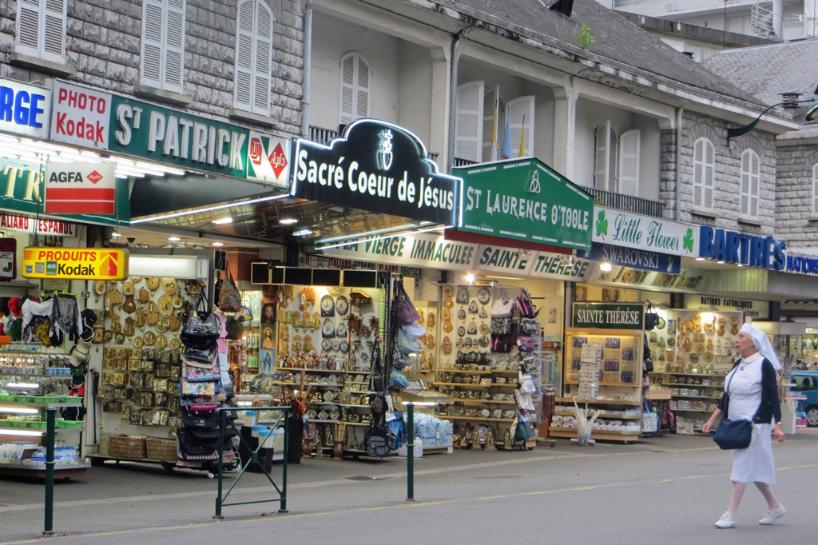
14 minute read
Remembering Past Pilgrimages - Time to Return
by Harry Robertson
With sharply reducing Covid levels and the increasing resumption of short-haul flights, now is the time to plan that long-promised pilgrimage. Attached are a few personal - and admittedly rather quirky – memories of pilgrimages to four of the great European locations: Lourdes; Fatima; Medjugorje and the Holy Land. Lourdes
Advertisement
Lourdes is very special to A&B Diocese because of the annual pilgrimage when more than 700 pilgrims from the Diocese, sick and able-bodied, travel for a week of prayer, praise, companionship and good French cooking. A small market town in southern France, in the foothills of the Pyrenees mountains, about 300 miles from the Spanish border, Lourdes is a town of about 15,000 souls – with 270 hotels to support the five million or more pilgrims who visit each
year. Its fame springs from the 1858 appearance of the Blessed Virgin Mary to 14-year-old Bernadette Soubirous on 18 occasions in the Massabielle
Grotto. She revealed herself as the ‘Immaculate Conception’ a term Bernadette did not understand but that had been declared by Pope Pius IX four years earlier. The Lady also told Bernadette to dig in the ground at a certain spot and then to drink from the small spring of water that began to gush forth. Almost immediately cures were reported from drinking the water. Lourdes was the first organised pilgrimage that my wife and I went on, about 10 years ago. As we passed near the site of the apparitions, my first impression was of wall-
to-wall souvenir shops (photo 1. Wall to wall tourist shops) and my heart sank. It soon rebounded
when I discovered that that the
Sanctuary of Our Lady of Lourdes, the ‘Domain’ as it is known, the area around the apparitions, was entirely commerce-free, a place of peace and holiness, containing the Grotto as well as taps to dispense the Lourdes water, several churches and basilicas, and some administrative offices.
My favourite time to visit the Grotto was late in the evening when the crowds had gone, it was cool and the hubbub of daytime noise was stilled. (photo 2. Evening in the Grotto) On the other hand, early mornings were almost as special. Rising soon after dawn, the streets were silent and deserted apart from the occasional workmen, leaf-blowing or watering the streets. Shivering slightly, we climbed the hill next to the Basilica of the Immaculate
Conception to reach the beautiful and moving Stations of the Cross (photo 3. The High Stations of the Cross). High above the town, with the snow-capped mountain tops of the Pyrenees in the distance, we stood in front of each Station, as the Leader proclaimed: ‘We adore Thee, O Christ, and bless Thee’, to which we responded ‘Because by Thy holy cross Thou hast redeemed the world’.

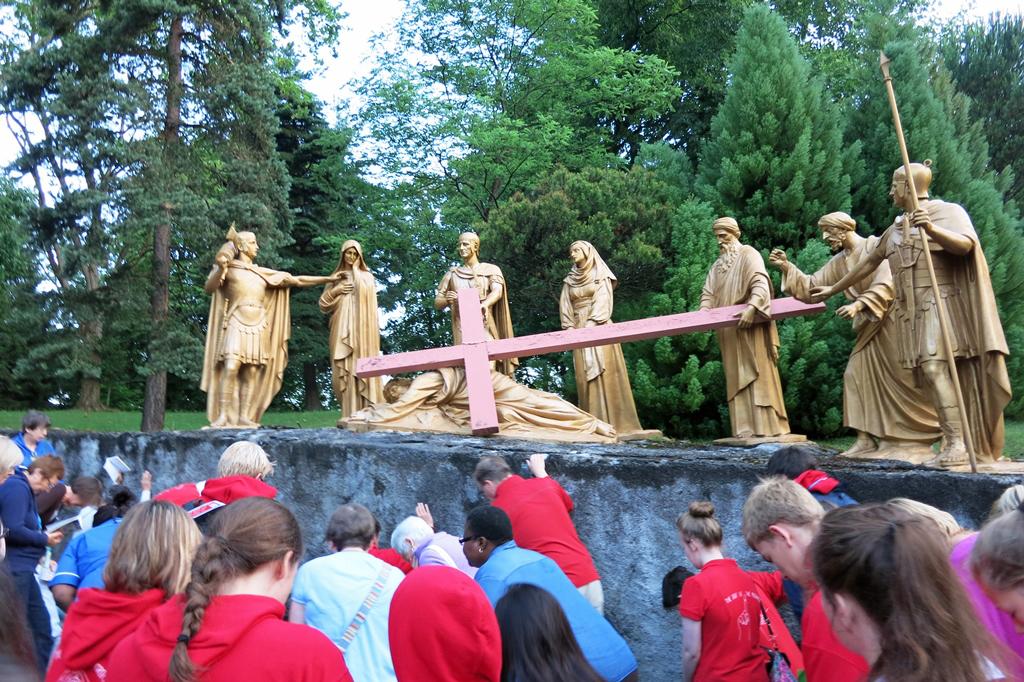
The Domain is beautiful. My favourite place, apart from the Grotto, was the spectacular Basilica of Saint Pius X, a concrete structure, completed in 1958 and almost entirely underground. The interior is vast with concrete beams crossing the ceiling, making it seem as if one was inside an upturned boat – a huge one, capable of holding 25,000 worshippers (photo 4. The Basilica of St Pius X). It also contains a relic of St John Paul II, a piece of the soutane he was wearing on 13th May 1981 that is marked with his blood from the attempt to assassinate him. Fatima
Fatima is the younger sister of Lourdes, renowned for the apparitions of the Blessed Virgin Mary to three young shepherds in 1917. It is in central Portugal, about 90 miles north of Lisbon. To my mind, the two sites are very different. Lourdes reflects the light and warmth of the Virgin Mary, its healings of body and spirit speak of God’s love and forgiveness. The gaiety of the town and the sparkling fast-flowing Gave de Pau river that runs through the town reflect life in its fullness.
Fatima with its bare, sun-scorched earth is more sombre, perhaps reflecting human sinfulness meriting
The Basilica of St Pius X

God’s justice and retribution – as well as expressing His love and desire for reconciliation through prayer and sacrifice leading to grace and mercy (photo 5. Basilica of Our Lady of the Rosary in Fatima). The Fatima apparitions took place in a country where the new republic was hostile to the Church, and the Blessed Virgin spoke of the need for Acts of Reparation and prayers to console Jesus for the sins of the world – indeed, she gave the children a terrifying vision of Hell. Two of the three child seers then died early, from the flu pandemic, at the ages of nine and ten. One other significant difference between Lourdes and Fatima was the miracle of natural phenomena provided to the huge crowd gathered at Fatima, when the sun was seen to ‘dance’ in the sky or omit multi-coloured lights, visible to many thousands of those present. I thought about that more sombre side as I watched pilgrims shuffling on their knees across the vast square in front of the Basilica of Our Lady of the Rosary. (photo 6. Approaching the Basilica on their knees). Two of the child seers – canonised in 2017 – are interred in the
Basilica of Our Lady of the Rosary in Fatima

Basilica, as is the body of the third, Sister Lucia. There are also are altars dedicated to each of the
15 mysteries of the Rosary. We visited Fatima in 2017, during the centenary celebrations of the apparitions. Opposite the Basilica of Our Lady is the Basilica of the Most Holy Trinity and in front of it was a giant Rosary, a spectacular work of art that was illuminated at night time. It was a wonderful tribute to the significance of the Rosary in both the Lourdes and the Fatima apparitions (photo 7. The Illuminated Rosary). Another link between Lourdes and Fatima was
that both the apparitions were given to peasant children. We visited the former prison building in Lourdes where St Bernadette’s family took refuge after the father became unemployed in 1857; it was from that site that Bernadette set off to
collect dry wood in the Massabielle Grotto. Similarly, the two houses of the Fatima visionaries in the village of Aljustrel have been maintained and filled with period furnishings to evoke just how simply peasants lived 100 years ago. It amused me to see huge tourist buses navigating the narrow, winding streets. (photo 8. Navigating the streets in Aljustrel). There is a moving story that eight-year-old St Francisco used to skip school to visit the church and pray before the ‘Hidden Jesus’ in the tabernacle. The steps where he crouched down Approaching the Basilica on their knees


The Illuminated Rosary

Navigating the streets in Aljustrel
provided some concealment and he used to pray there for hours, keeping God company. (photo 9. Keeping God company) Sick with flu, Francisco and Jacinta still attended church for Mass, kneeling before the Eucharist. Believing his death was near, Francisco asked to receive the ‘Hidden Jesus’ in his first Holy Communion on April 3, 1909 – and died the following day. Medugorje I was living and working in Asia in the 1980s when the phenomena of Medugorje took off, with six children claiming they had seen the Blessed Virgin Mary, amid reports of healings, apparitions, the sun ‘dancing,’ metal on Rosaries turning a golden colour, crosses of light in the sky, conversions, irresistible urges to attend confession and wonderful fruits, including impressive charity works. For various reasons I did not feel able to travel to
Medugorje until 30 years later, in 2015. Perhaps it was because I felt unable to take the miracles at face value, particularly since the Church, the local episcopate as well as Pope Francis, had serious reservations about the apparitions. While the Vatican hesitates to affirm the apparitions – understandably, not least because they are on-going and any future ‘message’ could contradict Church teaching – people have voted with their feet and an estimated 16 million or more have now visited the site.
Indeed, in 2017 Pope Francis appointed a special envoy to Medugorje and in 2019 he authorised pilgrimages there in view of the ‘abundant fruits of grace that have sprung from it.’ However, the Director of the Holy See’s Press Hidden steps for keeping God company
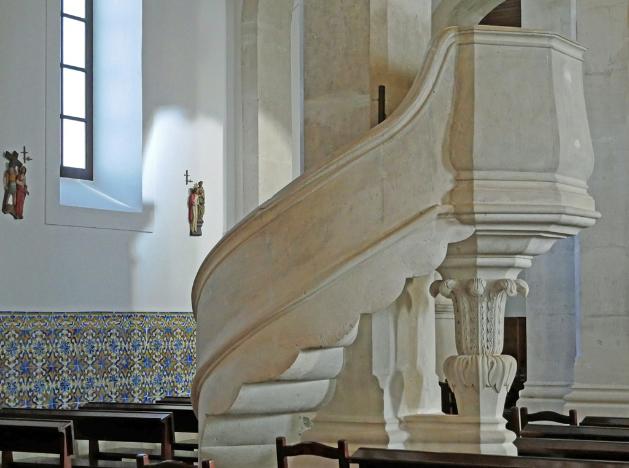

St James Church
Office emphasised that the authorisation should not be considered ‘an authentication of known
events, which still require examination by the Church’.
So, in 2015 our plane touched down in Split Airport in Croatia and we took a minibus over the mountains to Medjugorje in the southwest part of Herzegovina (the southern part of Bosnia and Herzegovina Federation). Our guide requested that we pray the Rosary
non-stop during the journey. After an hour or so the bus seemed to be climbing steeply so I glanced out the window – and wished I had not. The road fell away steeply; several hundred feet below was the valley floor. I resumed praying with some urgency and at last we arrived safely in Medugorje – the first miracle - and I saw St James Church, location of some of the apparitions. (photo 10. St James Church) This is farming country; the parish of Medugorje, population about 4,500, is renowned for its fruit and vegetables, with cherry, plum, pear, peach, apple and apricot trees, but perhaps even more so for its harvests of tobacco and wine. It is also
very hilly, with steep, rocky hills full of boulders and sharp-edged rocks. Two hills were key destinations for pilgrims: Apparition Hill where Our Lady allegedly appeared to the visionaries and Cross Mountain with its large concrete cross that towers over the valley below. We had followed the pilgrim guidance notes to the letter and came well equipped with stout hill-walking boots and two hiking sticks - we even practised on the quiet and smooth roads of Hove.
One sunny day I was making a huge effort, inching up the steep incline of Apparition Hill, jagged rocks to right and left, scree breaking away beneath my feet, the sun hot on my back and sweat trickling into my eyes…when I saw or sensed a blur at the corner of my eye. An eighty-year-old Irish granny wearing plimsolls swept past, her feet barely touching the ground the second miracle.
Sadly, the granny and other family members were in Medjugorje with a particular intention in mind; to pray for a family member who had a serious drug addiction. Shortly afterwards, the emergency rescue team with their stretcher also passed by and I slowed down even more, if that was possible. (photo 11. The Rescue Team) It wasn’t all toil and trouble. Near the base, at the blue cross, which marks the spot where the apparitions were reported to have taken place, a prayerful spot if ever there was one, (photo 12. The Blue Cross) we thanked God for His goodness and felt particularly close to Him. There must be something about mountains; Jesus often sought out high mountains to pray or meet with the apostles. In a sense we were all looking for the Lord in the heights. (photo 13.

Cross Mountain, climbing to meet the Lord) And to answer the unspoken question: ‘Yes’, Medjugorje is indeed a place where the spirit feels the urge to reconcile with God. There were about 50 confessionals with most
languages catered for and queues most evenings. Unexpectedly, since I had developed a (fairly) regular confession habit, I felt a keen desire to audit my own life and dig deep until I found something that I had not yet confessed – the third miracle.
The Holy Land is surely the summit of pilgrimages; the place where our Lord was born, lived, ministered, suffered, died, was buried, rose again and ascended into glory. In 2013 we joined a pilgrimage visiting Bethlehem, Jerusalem, the Jordan River, Galilee, the Dead Sea and several other places. The first surprise was that Israel is tiny. It is only six miles from Jerusalem to Bethlehem, 14 to the Dead Sea and around 70 to Nazareth
and the Sea of Galilee. The second surprise was that the Arab/Israeli antagonism was still so deadly serious and omnipresent. On the first day we made the short drive from Jerusalem to Bethlehem, stopping at a massive security wall, a scar on the landscape that had become a tourist stop. (photo 14. Security Wall near Bethlehem) Our guide was a Palestinian Christian Arab who was able to explain the The Blue Cross
Cross Mountain, climbing to meet the Lord
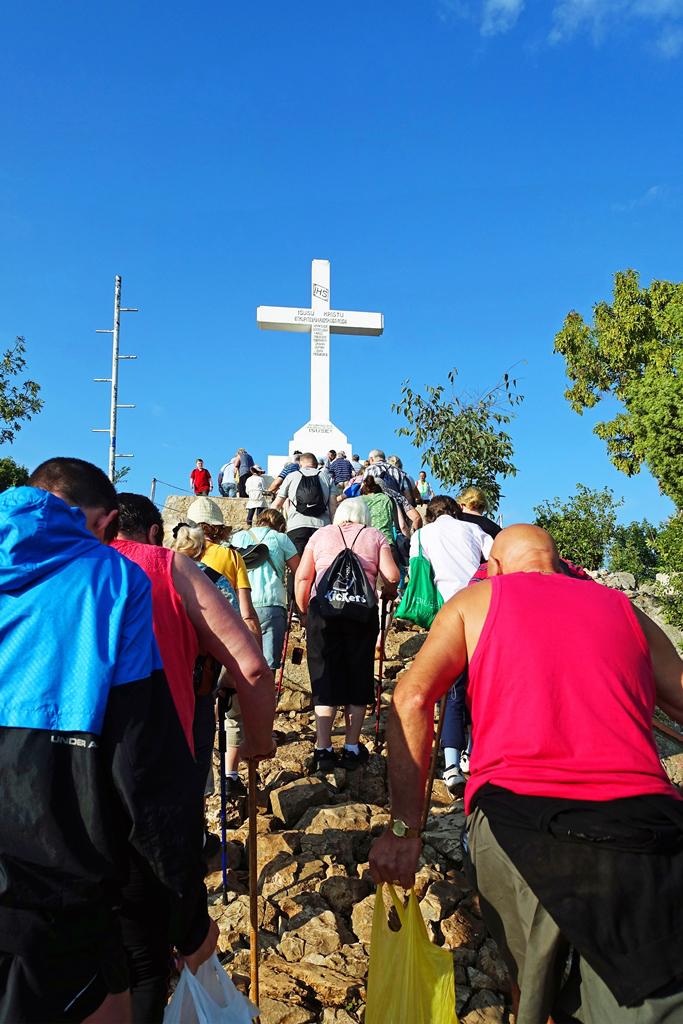

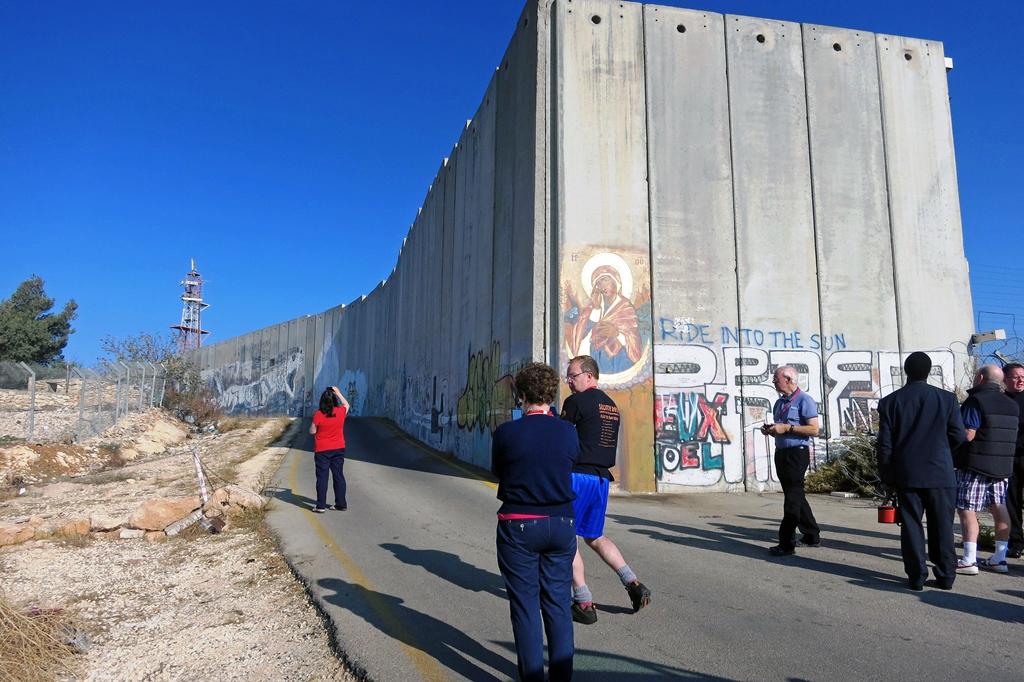
challenging Arab and Christian experiences of daily life in Israel. Wandering around Jerusalem, we were frequently reminded of the security situation, whether it was the sudden roar of a fighter plane overhead, troops lounging in the shade of an ancient building or armed soldiers filtering through the crowded bazaars in the Old City. In many ways Jerusalem lived up to our expectations and it was a case of ‘If only these walls could speak.’ While the traditional highlights of the pilgrimage, such as the Church of the Holy Sepulchre and the Via Dolorosa, made the expected impact, three other locations also spoke loudly. Since ancient times traditional Jews have longed to be buried in Jerusalem (particularly on the Mount of Olives, some believing that resurrection will begin from that location) and I was amazed by the size of the cemetery on the Mount of Olives, considered to be the largest and holiest Jewish cemetery on earth with as many as 150,000 tombs. (photo 15. Mount of Olives Jewish Cemetery) Among the buried are, as expected, rabbis and religious scholars, businessmen, cultural and political figures, scientists – and the late Prince Philip’s mother, Princess Alice of Battenberg, who was recognised as ‘Righteous among the Nations’, an honour given to non-Jews who risked their lives to save Jews during the Holocaust. Security Wall near Bethlehem
ancient-looking olive trees there. (photo 16. Olive Trees in Garden of Gethsemane) I read recently that an Italian research study found that some of the trees dated from the year 1092AD and were probably planted from earlier versions. But, of all the sights in Israel, there is one in particular that stubbornly remains in my memory. In Luke 4:38 we are told that Jesus left the synagogue and went to Simon Peter’s house where his mother-in-law was very sick with a high fever. Jesus promptly healed her and she got up and began serving them. Jesus himself, for much of his adult life, also lived in the same small fishing village of Capernaum on the Sea of Galilee. Italian archaeologists working in Capernaum discovered what they believe to be compelling circumstantial evidence of the location of the Apostle Simon Peter’s house. Digging below the ruins of an early Byzantine martyr’s church, they found an ordinary house that had been transformed in the mid-first century AD into a communal gathering place - possibly the first church ever – with ancient religious graffiti on the walls. By the fifth century an octagonal Byzantine martyr’s church had been built over it, carefully preserving the original main room below, in a similar way to how other martyr’s residences were preserved underneath early churches in Israel. A modern church (photo 17. Pilgrimage Church of St. Peter, Capernaum) now replaces the Byzantine one, revealing the original 1st century room below (photo 18.House of St Peter?). Even better, just a very short walk away are the well-preserved ruins of a synagogue dating to the first century, presumably the one where Jesus attended and taught. It is very easy to imagine Jesus walking between the two. As someone said, Israel is indeed ‘the fifth Gospel’.
Mount of Olives Jewish Cemetery
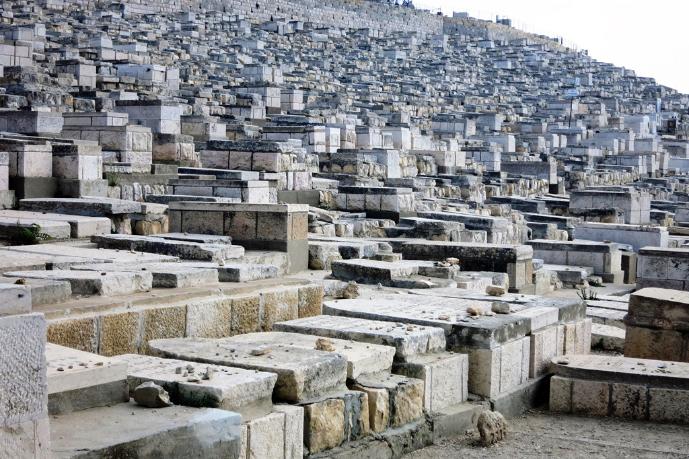
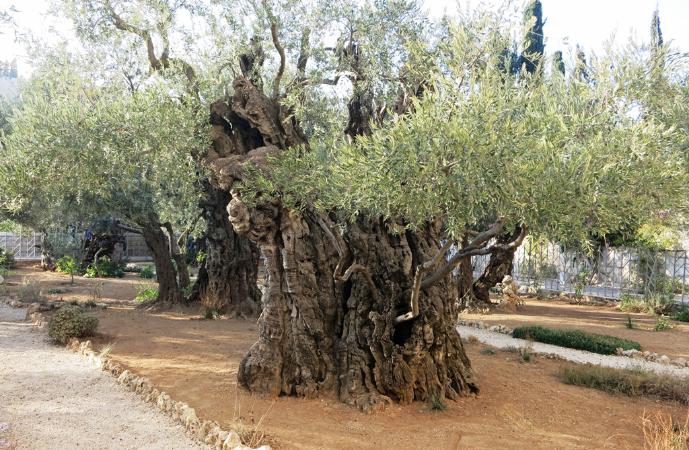
Olive Trees in Garden of Gethsemane

Pilgrimage Church of St. Peter, Capernaum
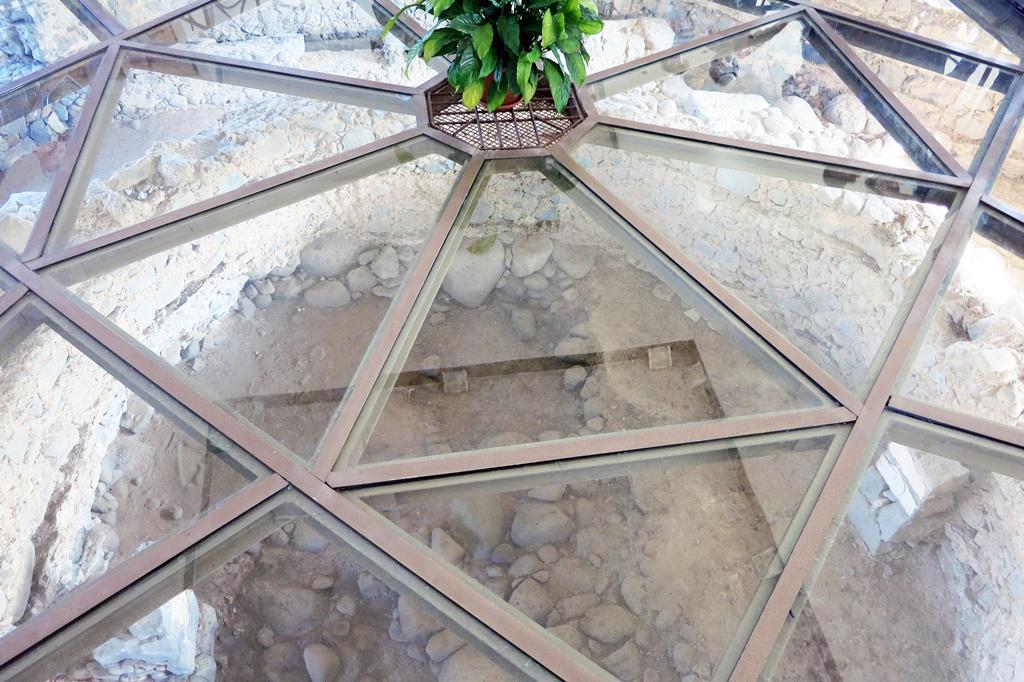
House of St Peter










